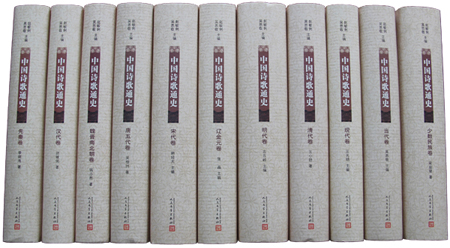Volume of Ethnic Minority, General History of Chinese Poetry

Published by People’s Literature Publishing House in June 2012, Liang Tingwang’s Volume of Ethnic Minorities, forms the 11th volume of the series General History of Chinese Poetry. Volume of Ethnic Minorities closely connects minorities’ poetry with Han poetry while keeping in form the design of General History of Chinese Poetry‘s editorial board.
Spanning up to the present, Volume of Ethnic Minorities depicts a relatively complete and comprehensive record of Chinese ethnic minority poetry. The volume has 13 chapters and 55 sections, containing approximately one million Chinese characters,. The volume fulfills its duties as a history, introducing ethnic minorities’ poetry and literary trends during different historical periods, and goes beyond well beyond any primer, delving into poetry, folklore, heroic epics and even folk songs.
Zhao Zhizhong, director of the Institute for Minority Literature at Minzu University of China, commented that the volume is not only masterfully introduces Chinese ethnic minorities’ poetry and poets, but also intelligently summarizes the significance of poetic creations and broader literary movements in minority history.
The volume divides the process of minority poetry’s development into five stages: a foundational period of ancient poetry; the developmental period of ancient poetry; the golden age of ancient poetry; the transitional period of modern poetry; and the formative period of contemporary poetry. Zhao Zhizhong praised Liang’s division as being well-thought out and the product of a meticulous consideration. Zhao reflected on the incredible cultural and material differences of Chinese ethnic minorities—living spaces, modes of production, traditions and customs and religion beliefs are totally different—which has lead to their poetry possessing completely distinct characteristics. Liang himself similarly observed the uniqueness of minority poetry, ranging from the diversity of its integral structure and variety of its internal structure, abundant ethnic elements, and complicated and dynamic usage of languages to different art styles and the permeation of religious overtones. The volume is a significant contribution to the construction of theoretical interpretations of Chinese ethnic minority poetry, Zhao Zhizhong added.
The Chinese version appeared in Chinese Social Sciences Today, No. 478, July 22, 2013
Translated by Zhang Mengying
Revised by Charles Horne

 PRINT
PRINT CLOSE
CLOSE